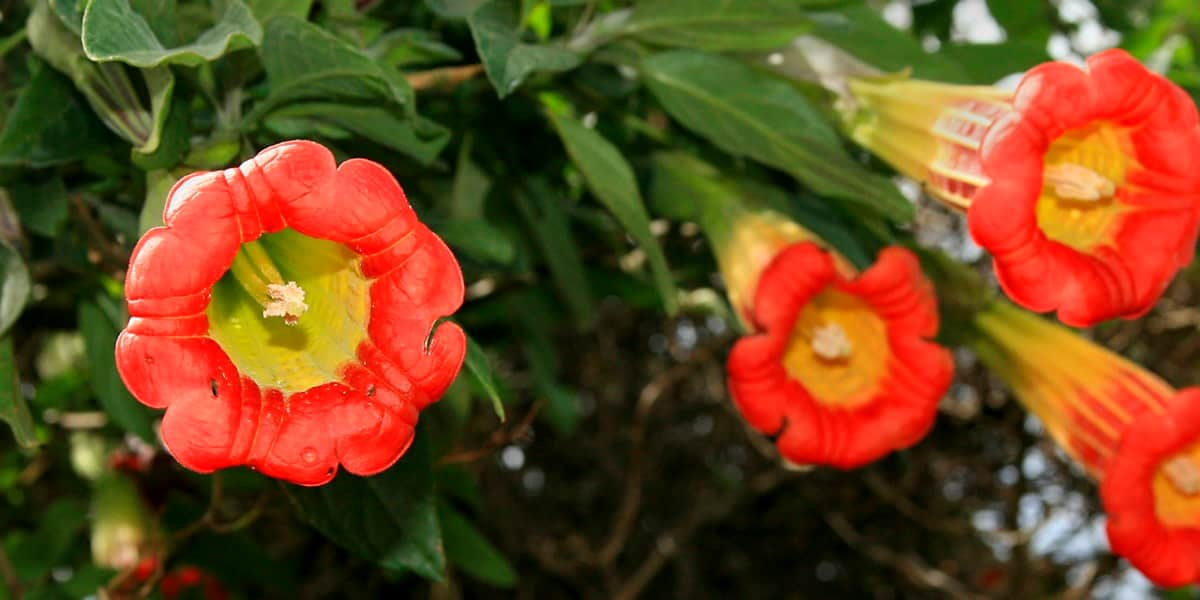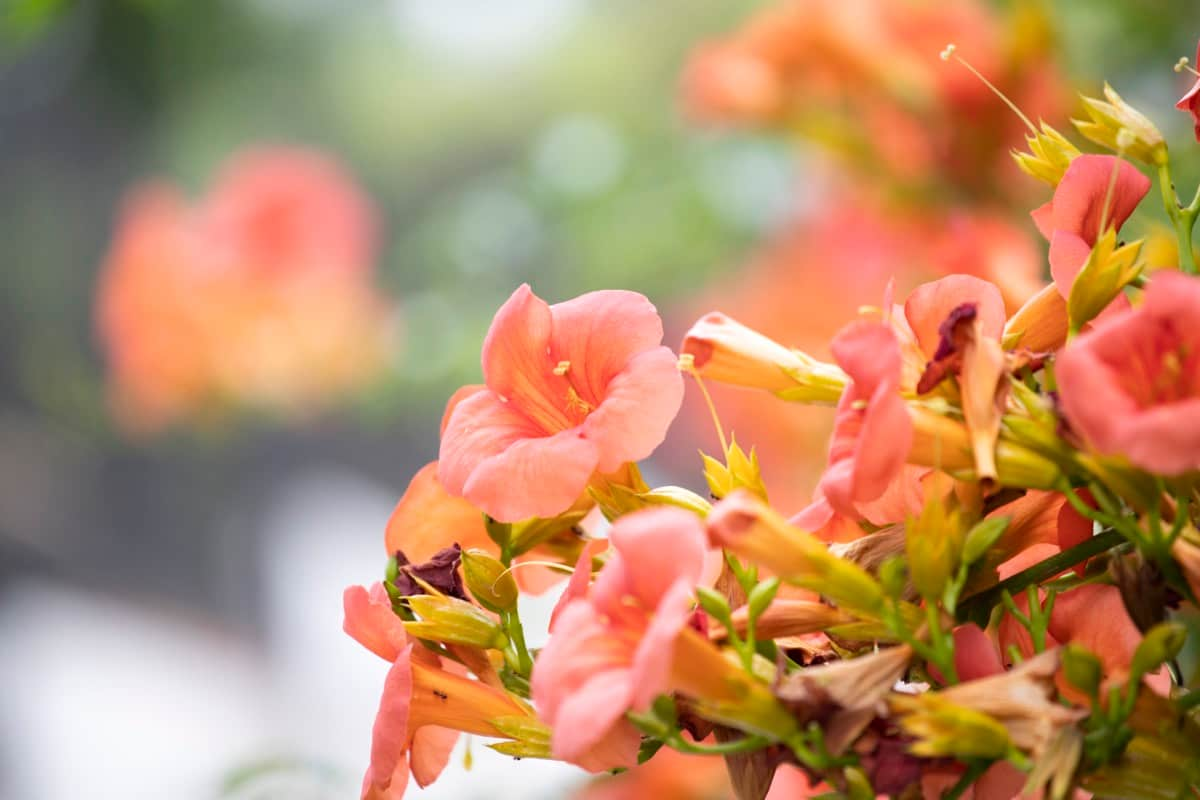Red Trumpet Creeper (Campsis radicans), or trumpet creeper, is a fast-growing perennial vine. Growing trumpet vine creepers is easy, and although some gardeners consider the plant invasive, with adequate care and pruning, trumpet vines can be kept under control. Keep reading to learn more about how to grow trumpet vine. Here are some planting instructions to help you get started.

How to Grow and Care for Red Trumpet Creeper
Red Trumpet Creeper Planting Guide: Tips for Successful Growth
- Red trumpet creepers need a location with plenty of sunlight. They like well-drained soil, so make sure your chosen location has good drainage.
- Before planting, ensure to prepare the soil. Add organic matter and compost to improve the soil quality. This will help the plant grow stronger and healthier.
- Dig a hole enough to accommodate the plant’s roots when planting. Plant the red trumpet creeper at the same depth as in the container. Water the plant thoroughly after planting.
- Red trumpet creepers need regular watering, especially during the growing season. Water the plant deeply once a week, and ensure the soil doesn’t dry out completely.
- Feed fertilizers to the plant once a month during the growing season. Use a balanced fertilizer to provide the plant with the necessary nutrients.
- Prune the plant during early spring to remove any dead or damaged branches. This will help the plant grow stronger and healthier.
- Red trumpet creepers need support to grow. Provide a trellis or other support structure for the plant to climb.
Watering and Soil Requirements for Red Trumpet Creeper Vines:
Soil: The vines are tolerant of various soil types, including sandy, loamy, and clay soils, and are naturally attracted to moist, well-drained soils. They are usually found in seasonal swamps and forest thickets in their native habitat. The red trumpet creeper vine prefers slightly acidic soil with a pH range between 6.0 and 6.5. Apply sulfur to lower the pH of the soil in your area if the soil is too alkaline.
Water: The trumpet vine prefers moderate soil moisture but is tolerant of drought as well. When the plants show obvious signs of wilting or withering, they only need to be watered. As long as the plants receive enough rainfall, they will be healthy in most climates. Rainfall and irrigation combined with about one inch of water per week are sufficient for good plant growth.
Sunlight Needs for Thriving Red Trumpet Creeper Plants
Red Trumpet Creeper plants require full sunlight exposure. This means they should be planted in an area that receives at least six to eight hours of direct sunlight daily. It is crucial to ensure that no obstructions, such as trees or buildings, block the sunlight from reaching the plant. It is also important to note that Red Trumpet Creeper plants can tolerate some shade but will not thrive in low-light conditions. If you must plant them in an area with less sunlight, provide them with at least four hours of direct sunlight daily.
Pruning Techniques for Shaping and Maintaining Red Trumpet Creeper
Due to its fast growth and spread, trumpet vines can quickly become a nuisance if left unchecked. However, this plant’s shape and growth can be controlled and maintained with careful trimming. In late winter or early spring, prune your trumpet vines before new growth appears.
The long lateral shoots should be pruned about two nodes before growth begins. A trumpet vine bursts into many seeds after it finishes blooming. These seeds are reminiscent of giant green beans. Seeds from trumpet vine can spread throughout your garden. Remove these seed pods before they fully ripen to reduce the chance of trumpet vines taking over.
Protecting Red Trumpet Creeper from Pests and Diseases: Prevention and Treatment
- Neem oil is one of the organic pesticides that can treat various pests, including aphids, spider mites, and whiteflies. It works by disrupting the insect’s life cycle, preventing it from reproducing.
- A mixture of water and soap can treat pests such as mealybugs and scale insects. The soap disrupts the insect’s cell membranes, causing it to dehydrate and die.
- Copper fungicide is an organic treatment that can prevent and treat fungal diseases like powdery mildew and rust. It creates a barrier on the plant’s surface, preventing the fungus from spreading.
In case you missed it: How to Grow and Care for Rose Plants: Propagation and Planting Instructions for Best Blooms

Harvesting and Propagating Red Trumpet Creeper Seed
- Wait until the seed pods are dry and brown before harvesting the Red Trumpet Creeper seed. The seed pods will be located where the flowers were.
- Cut the seed pods off the vine carefully to avoid damaging them. Place these seed pods in a paper bag and let them dry for a few days.
- Once the pods are dry, open them up and remove the Red Trumpet Creeper seeds. The seeds will be small and black.
- Soak the Red Trumpet Creeper seeds in warm water for 24 hours. This will help to break down the seed coat and increase germination rates.
- Plant the Red Trumpet Creeper seeds in a well-draining soil mixture. Keep the soil moist and warm; the seeds should germinate in 2-4 weeks.
- Once the Red Trumpet Creeper seedlings have grown a few inches tall, they should be transplanted to their permanent location.
Winter Care for Red Trumpet Creeper: Protecting Against Freezing Temperatures
Red Trumpet creepers can withstand freezing temperatures in areas that don’t get below -10°C, as an extreme temperature during winter. Their roots must be protected from the winter cold if planted in pots or containers. Alternatively, you can bring the container inside to be fully protected from the weather.
Transplanting Red Trumpet Creeper: Step-by-step Instructions
- The best time to transplant a red trumpet creeper is early spring, just before new growth begins.
- Choose a new location with full sun, partial shade, and well-draining soil. Dig a hole twice as wide as the root ball of the plant and the same depth as the root ball.
- Prune the red trumpet creeper back by one-third to one-half of its size. This will reduce transplant shock and encourage new growth.
- Carefully dig up the red trumpet creeper, getting as much root ball as possible. If the plant is large, you may need help from another person to lift it from the ground.
- Move the red trumpet creeper to its new location quickly to avoid drying out the roots.
- Place the plant in the hole and backfill it with soil, gently tamping it around the root ball. Water the plant thoroughly, making sure the soil is evenly moist.
- Apply a layer of mulch around the plant’s base to help retain moisture and suppress weed growth.
- Maintain moisture in the soil for the first few weeks after transplanting. Once the plant becomes established, it will require less frequent watering.
Encouraging Abundant Red Blooms in Trumpet Creeper: Fertilizing Tips
- Fertilize during early spring before new growth appears and again in mid-summer after the first flush of blooms has faded.
- Use a high-phosphorus fertilizer, such as a 5-10-5 or 10-20-10 blend. Phosphorus promotes flower production.
- Apply the fertilizer based on the package instructions, usually about 500 grams per 100 square feet of soil. Spread it evenly around the plant’s base, not letting it touch the stem.
- After applying the fertilizer, water the plant thoroughly to help absorb the nutrients.
- Too much fertilizer can cause excessive leaf growth at the expense of blooms, so be sure to follow the package instructions and not exceed the recommended amount.
Common Problems in Red Trumpet Creeper Care: Troubleshooting and Solutions
Improper pruning: Red Trumpet Creeper requires regular pruning to control its growth and shape. However, improper pruning can damage the plant and stunt its growth. To avoid this issue, prune the plant correctly, following proper pruning techniques and timing.
Lack of Blooms: One of the most common problems gardeners face when growing red Red Trumpet creepers is the lack of blooms.
- If your plant is not blooming, it could be due to a lack of sunlight. Red trumpet creeper requires full sun exposure to produce blooms. If your plant is not getting enough sunlight, try moving it to a sunnier location.
- Another reason for the lack of blooms could be over-fertilization. Over-fertilization can lead to abundant foliage growth, leaving little energy for blooming. To solve this problem, reduce the frequency of fertilization and use a low-nitrogen fertilizer.
In case you missed it: How to Grow and Care for Poppy Flowers: Planting Instructions

Conclusion
Following these planting instructions, you can successfully grow and care for red trumpet creepers in your garden. Enjoy the beautiful flowers, hummingbirds, and butterflies attracted to them!
- Feed Your Flock for Less: Top 10 Tips to Save on Chicken Feed
- Ultimate Guide to Ossabaw Island Hog: Breeding, Raising, Diet, and Care
- Hatching Answers: The Top 10 Reasons Your Chickens Aren’t Laying Eggs
- Eggs and Economics: Breaking Down the Cost of Raising Backyard Chickens
- Defend Your Greens: Proven Methods to Keep Iguanas Out of Your Garden
- Ultimate Guide to Cinnamon Queen Chicken: A Comprehensive Guide for Beginners
- Ultimate Guide to California Tan Chicken: Breeding, Raising, Diet, Egg-Production and Care
- Ultimate Guide to Marsh Daisy Chicken: Breeding, Raising, Diet, and Care
- 10 Types of Chicken Farming Businesses You Can Start for Profits